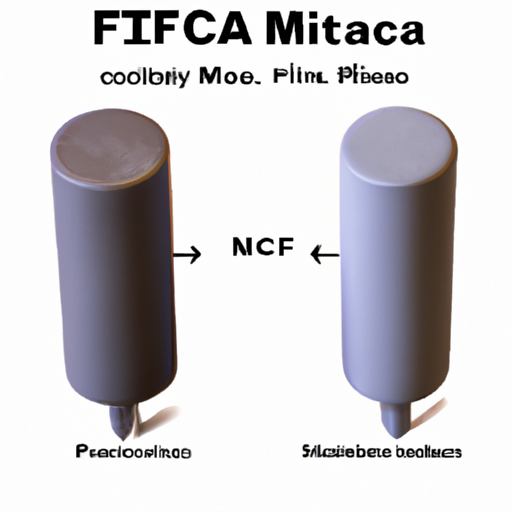Mica and PTFE Capacitors: Core Functional Technologies and Application Development Cases
Mica and PTFE (Polytetrafluoroethylene) capacitors are specialized electronic components known for their unique properties, making them essential in various high-performance applications. Below, we delve into the core functional technologies, advantages, and notable application development cases for both types of capacitors.
Core Functional Technologies
Mica Capacitors
1. **Dielectric Properties**: Mica capacitors utilize natural mica as a dielectric material, which offers exceptional stability, low loss, and high insulation resistance. This stability allows them to maintain capacitance values over time, even under varying environmental conditions.

2. High Voltage Ratings: These capacitors can handle high voltages, making them ideal for power electronics and RF (radio frequency) circuits, where voltage stability is crucial.
3. Low Temperature Coefficient: Mica's low temperature coefficient ensures that capacitance remains stable across a wide temperature range, making these capacitors suitable for precision applications.
4. Mechanical Stability: Mica capacitors are robust and can withstand mechanical stress, making them suitable for environments subject to vibration or shock.
PTFE Capacitors
1. **Chemical Resistance**: PTFE capacitors are renowned for their excellent resistance to chemicals, making them suitable for harsh environments where exposure to corrosive substances is a concern.
2. Low Loss Factor: The low dissipation factor of PTFE results in minimal energy loss, making these capacitors ideal for high-frequency applications.
3. Wide Temperature Range: PTFE capacitors can operate effectively from -55°C to +200°C, which is advantageous in extreme conditions.
4. Low Dielectric Constant: The low dielectric constant of PTFE allows for the design of capacitors with high capacitance values in smaller packages, beneficial for space-constrained applications.
Application Development Cases
Mica Capacitors
1. **RF and Microwave Applications**: Mica capacitors are extensively used in RF amplifiers, oscillators, and filters due to their stability and low loss characteristics. For instance, in telecommunications, they are integral to RF power amplifiers, ensuring signal integrity and performance.
2. High-Voltage Power Supplies: These capacitors are employed in high-voltage power supply circuits where reliability is critical. Their ability to handle high voltages without failure makes them suitable for applications in medical equipment and industrial machinery.
3. Precision Timing Circuits: Mica capacitors are ideal for applications requiring precise timing, such as oscillators and timers, due to their stability and accuracy.
PTFE Capacitors
1. **Aerospace and Defense**: PTFE capacitors are used in aerospace applications due to their lightweight, high reliability, and resistance to extreme temperatures and chemicals. They are commonly found in avionics systems and radar equipment.
2. Automotive Electronics: With the rise of electric vehicles, PTFE capacitors are increasingly utilized in automotive electronics for power management systems, where thermal stability and low loss characteristics are essential.
3. Medical Devices: In medical applications, PTFE capacitors are used in devices such as MRI machines and ultrasound equipment, where reliability and performance are critical in sensitive environments.
4. Telecommunications: PTFE capacitors are also employed in telecommunications infrastructure, including base stations and satellite communications, where high-frequency performance and reliability are paramount.
Conclusion
Mica and PTFE capacitors each offer unique advantages that make them suitable for a variety of demanding applications. Mica capacitors excel in high-voltage and precision applications, while PTFE capacitors are favored for their chemical resistance and performance in extreme conditions. As technology continues to evolve, the demand for these capacitors in advanced applications is likely to grow, driving further innovation and development in capacitor technology. Their continued use in critical sectors such as aerospace, automotive, telecommunications, and medical devices underscores their importance in modern electronics.
Mica and PTFE Capacitors: Core Functional Technologies and Application Development Cases
Mica and PTFE (Polytetrafluoroethylene) capacitors are specialized electronic components known for their unique properties, making them essential in various high-performance applications. Below, we delve into the core functional technologies, advantages, and notable application development cases for both types of capacitors.
Core Functional Technologies
Mica Capacitors
1. **Dielectric Properties**: Mica capacitors utilize natural mica as a dielectric material, which offers exceptional stability, low loss, and high insulation resistance. This stability allows them to maintain capacitance values over time, even under varying environmental conditions.

2. High Voltage Ratings: These capacitors can handle high voltages, making them ideal for power electronics and RF (radio frequency) circuits, where voltage stability is crucial.
3. Low Temperature Coefficient: Mica's low temperature coefficient ensures that capacitance remains stable across a wide temperature range, making these capacitors suitable for precision applications.
4. Mechanical Stability: Mica capacitors are robust and can withstand mechanical stress, making them suitable for environments subject to vibration or shock.
PTFE Capacitors
1. **Chemical Resistance**: PTFE capacitors are renowned for their excellent resistance to chemicals, making them suitable for harsh environments where exposure to corrosive substances is a concern.
2. Low Loss Factor: The low dissipation factor of PTFE results in minimal energy loss, making these capacitors ideal for high-frequency applications.
3. Wide Temperature Range: PTFE capacitors can operate effectively from -55°C to +200°C, which is advantageous in extreme conditions.
4. Low Dielectric Constant: The low dielectric constant of PTFE allows for the design of capacitors with high capacitance values in smaller packages, beneficial for space-constrained applications.
Application Development Cases
Mica Capacitors
1. **RF and Microwave Applications**: Mica capacitors are extensively used in RF amplifiers, oscillators, and filters due to their stability and low loss characteristics. For instance, in telecommunications, they are integral to RF power amplifiers, ensuring signal integrity and performance.
2. High-Voltage Power Supplies: These capacitors are employed in high-voltage power supply circuits where reliability is critical. Their ability to handle high voltages without failure makes them suitable for applications in medical equipment and industrial machinery.
3. Precision Timing Circuits: Mica capacitors are ideal for applications requiring precise timing, such as oscillators and timers, due to their stability and accuracy.
PTFE Capacitors
1. **Aerospace and Defense**: PTFE capacitors are used in aerospace applications due to their lightweight, high reliability, and resistance to extreme temperatures and chemicals. They are commonly found in avionics systems and radar equipment.
2. Automotive Electronics: With the rise of electric vehicles, PTFE capacitors are increasingly utilized in automotive electronics for power management systems, where thermal stability and low loss characteristics are essential.
3. Medical Devices: In medical applications, PTFE capacitors are used in devices such as MRI machines and ultrasound equipment, where reliability and performance are critical in sensitive environments.
4. Telecommunications: PTFE capacitors are also employed in telecommunications infrastructure, including base stations and satellite communications, where high-frequency performance and reliability are paramount.
Conclusion
Mica and PTFE capacitors each offer unique advantages that make them suitable for a variety of demanding applications. Mica capacitors excel in high-voltage and precision applications, while PTFE capacitors are favored for their chemical resistance and performance in extreme conditions. As technology continues to evolve, the demand for these capacitors in advanced applications is likely to grow, driving further innovation and development in capacitor technology. Their continued use in critical sectors such as aerospace, automotive, telecommunications, and medical devices underscores their importance in modern electronics.









